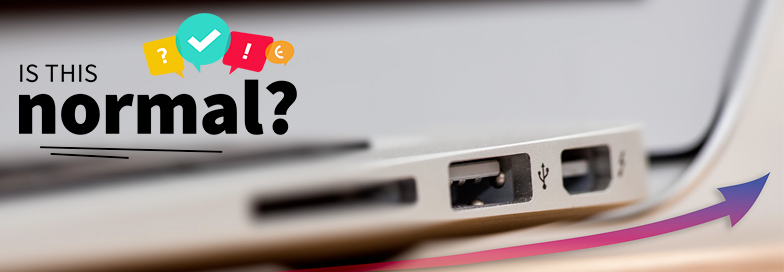
 I’m Rose, SWAT’s favorite (and only) trusty marketing intern. I am a college student who loves business and marketing but, unlike most SWAT employees, I am no tech guru. Luckily, whenever I get those head-scratching or deeply-intriguing questions, all I have to do is walk around the corner to get the answer. Follow along in this new monthly blog series as I get the answers to my everyday “Is This Normal?” tech questions.
I’m Rose, SWAT’s favorite (and only) trusty marketing intern. I am a college student who loves business and marketing but, unlike most SWAT employees, I am no tech guru. Luckily, whenever I get those head-scratching or deeply-intriguing questions, all I have to do is walk around the corner to get the answer. Follow along in this new monthly blog series as I get the answers to my everyday “Is This Normal?” tech questions.Today’s blog post stems from a recent experience I had with my brand new 13-inch MacBook Pro. Earlier this year, I decided to upgrade to the new MacBook Pro with the TouchBar. I’ve loved the performance and user experience that Apple is renowned for, but I was really surprised to hear the fan run loudly and feel the body of my laptop rapidly heat up. If my car started doing this, I’d jump out and call 911. Sure, I wasn’t that concerned, but my logic was that this is the newest model, so how could it possibly be overwhelmed already? Is my software or hardware defective? Is this normal?
I brought my laptop to the Apple Store where diagnostics were run to check for hardware issues. Everything passed with green checks, so my Apple rep’s next theory was that it was a software-related issues. We wiped my laptop and installed the previous operating system, Sierra (AKA we went from the fourteenth major release of macOS to the thirteenth). I was sent home with instructions to keep my laptop in “bare bones” mode, meaning I was not allowed to do a complete restore from any of my backups. I was supposed to wait 7 days to see if the issue had gone away, but I heard the roaring fan the next day. So, what the heck was going on?
I cashed in my SWAT Systems perks card and turned to Gabriel, our systems engineer turned Marketing Strategist extraordinaire. He has extensive experience working with Apple computers (he’s used one as his main laptop for over 10 years). After explaining to him how the fan makes the sound of a plane that’s taking off, he smiled and told me this was normal. I reiterated my laptop’s new-ness, the heat it generated, and how my old laptop didn’t make this much noise. Once again, he explained that my top-of-the-line Macbook Pro was doing exactly what it was built to do. *Sigh*
Yes, it’s normal: loud fan noises are a sign that your laptop has gotten warm.
It sounds like common sense, but the entire purpose of a laptop’s fan is to keep it cool. What I was frustrated at was not the fans, but at the item that was making my fans spin in the first place: the processor. Gabriel explained that the bigger (aka faster, more expensive) the laptop’s processor, the more number-crunching power it possessed. That number-crunching power will generate heat (insert physics here). Graphic designers, gamers, and video editors use big processors and graphics cards to help them process a lot of visual data. If you are a mega multi-tasker like me, I use that power to open (24) Chrome tabs, (3) PowerPoints, (1) Word document, (2) Excel spreadsheets, Photoshop, and Spotify – all at once.
While all the above made sense, I know that my fan has run at times when only one program is open. To disprove Gabriel’s explanation, I restarted my laptop and clicked on my Photos app (an iCloud app that syncs my iPhone pictures). Within 15 seconds of the program opening, my fan started running loudly! That can’t possibly be normal. However, Gabriel stepped in again to bust this myth. He said, “If you look back at the past 10 years, notice that all of our computer programs have gotten better and faster with every update. That’s because bigger, better, and faster computers are released each year.” Basically, programs are made to take advantage of as much power a computer can give to it in order to perform its tasks faster. The more processing power applications use, the warmer the processor will get. While my Photos app was sitting still in front of me, behind the scenes it was cataloging all of my photos by memories, dates and location. It was also scanning each one for faces so that it could group and tag photos categorically. Gabriel proved it to me by opening my Mac’s “Activity Monitor” and pointed at the high CPU number next to the Photos.
The 4 things that keep your heat and fans in check:
This whole experience opened my eyes to how hard our computers are working behind the scenes. Your laptop will use all of the power it has available since that’s what it was built for. Using this experience, I’d like to share the 4 steps I now take to ensure my laptop’s heat and fans are kept in check.
-
 This is a screenshot of my own Activity Monitor when my fan kicks off. 13.47% Idle load means ~87% of my CPU is being used.
This is a screenshot of my own Activity Monitor when my fan kicks off. 13.47% Idle load means ~87% of my CPU is being used.Use your computer’s activity monitor. Windows has “Task Manager” while Macs have “Activity Monitor.” They both display a list of every task and program that is using up your computer’s resources. The resource I keep an eye on is CPU (Central Processing Unit). These monitors are real-time and can show you which program is using a lot of CPU. For me, Google Chrome is often at the top, but when I run an intensive process like syncing my entire photo library from iCloud, I can see Photos shoot to the top. After my computer was restored, I ran the Photos app, my laptop fan kicked in, and I watched as my Idle (AKA at rest) percentage plummeted.
- Don’t use too many programs at once! I am so guilty of this and can feel my computer slow down as my fans kick in to keep it cool. Also, don’t be fooled by internet tabs. Google Chrome (and other major browsers) are now so sophisticated that each tab runs independently (which is why your whole browser doesn’t crash when a single tab dies or freezes). This also means each tab uses its own set of memory and CPU resources.
- Keep your programs updated. Developers are always finding bugs in their code that cause their programs to use unnecessary power. These are called memory or CPU leaks and it happens more frequently than not. When you update your programs, you might be installing a patch that makes your program run more efficiently.
- Help your computer breathe! Never use your laptop on a bed or other soft fabric surface. I know, it’s called a “lap top,” but Gabriel gave a metaphor of a marathon runner putting a t-shirt over their nose and mouth. The fabric suffocates your laptop’s vents and blocks the hot air from leaving your computer. If you still want to do work on a couch or bed, find a hardcover book (or textbook, in my case) to use as a hard surface under your device.
Hope you found this month’s “Is This Normal?” post helpful! If you have ideas of questions I could help answer in this segment, send it my way. Your question might be selected for our next “Is This Normal” blog post.
Email: hello@swatsystems.com
Subject: Is This Normal? – Blog Post Idea



